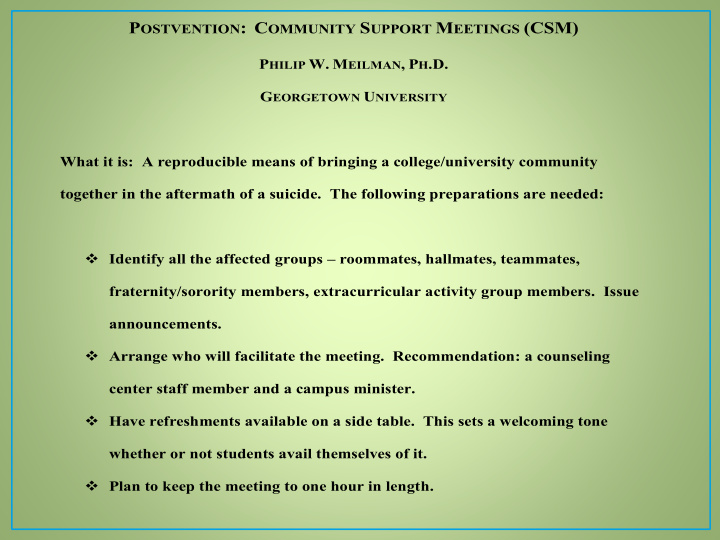



P OSTVENTION : C OMMUNITY S UPPORT M EETINGS (CSM) P HILIP W. M EILMAN , P H .D. G EORGETOWN U NIVERSITY What it is: A reproducible means of bringing a college/university community together in the aftermath of a suicide. The following preparations are needed: Identify all the affected groups – roommates, hallmates, teammates, fraternity/sorority members, extracurricular activity group members. Issue announcements. Arrange who will facilitate the meeting. Recommendation: a counseling center staff member and a campus minister. Have refreshments available on a side table. This sets a welcoming tone whether or not students avail themselves of it. Plan to keep the meeting to one hour in length.
STEP 1: Introduce staff who are present, explain confidentiality, and meeting duration. Request media representatives to identify themselves and to exit unless they are willing to put down their pens and participate solely as lay persons. STEP 2: Explain how the death occurred so that everyone is working from the same set of facts. STEP 3: Acknowledgement that this is a difficult time, compliment the students for attending and for their bravery.
STEP 4: The most important step. Ask those present to talk about the student who died to educate the facilitators about the deceased. Don’t be fearful of silences. Eventually students will tell stories, cry, laugh, be sad, be thankful. Let this go on for however long it takes. STEP 5: Briefly talk about the grieving process and that there is no right or wrong way to grieve. But keep it brief and do not give a lecture. STEP 6: Identify “what if’s,” and “if only’s . ” Ask those present to identify theirs or others ’ “what if’s . ” Then explain that suicide is so complex in its causes that changing any one of them would not have likely have made a difference.
STEP 7: Read from “Suggestions for Survivors,” by Iris Bolto n. Examples: “Struggle with ‘why’ it happened until you no longer need to know ‘why’ or until you are satisfied with partial answers,” and “Remember the choice was not yours. No one is the sole influence in another’s life.” (The full text of these 25 suggestions is available on line at http://www.didihirsch.org/suicide- prevention/beyond-surviving-suggestions-survivors.) All but two of the 25 suggestions are also appropriate for addressing non-suicide deaths. STEP 8: Parting comments: Talk about community and looking after one another, especially if somone is isolating or looks distraught. STEP 9: Identify resources on and off campus, including deans, clergy, the counseling, residence hall staff, peer counseling, telephone hotlines, faculty members, advisors, coaches, friends, and parents.
STEP 10 (If applicable): An announcement to stay after regarding planning for a memorial service, for those who are interested. STEP 11: An announcement that staff will stay for a few minutes afterward in case anyone wants to talk individually.
Recommend
More recommend